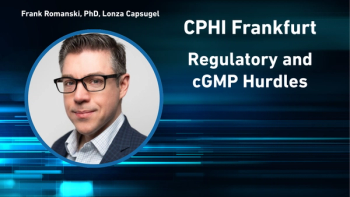
- Pharmaceutical Technology-06-02-2020
- Volume 44
- Issue 6
A Strategic Shake Up in Europe’s Medicines Sector
The EU’s pharmaceutical strategy has the potential to shake up the policies and regulations of the region’s medicines sector.
Editor’s Note: This article was published in Pharmaceutical Technology Europe’s June 2020 print issue.
The European Union has started drawing up a pharmaceutical strategy, which will be closely linked to a new EU industrial strategy and could trigger a shake-up of policies and regulations in the European medicines sector. Broad changes in some parts of the EU’s pharmaceuticals regulations have been on the cards since the European Commission (EC) introduced a regulations improvement programme (REFIT) five years ago to simplify legislation and make it less burdensome for business without compromising policy objectives (1).
A major driving force behind the pharmaceutical strategy, being drawn up by the EC for consultation due to start by the end of 2020, will be a desire to reverse Europe’s loss of its position as the global leader in the development and production of new medicines. Today almost half of global new drug treatments originate in the United States, according to the European Federation of Pharmaceutical Industries and Associations (EFPIA) in a report in March 2020 backing a new EU industrial and pharmaceutical strategy (2).
In 2014–2018, only 25% of new drugs emanated from Europe (2). “[This] represents a reversal of the medical innovation landscape [25 years ago],” commented Nathalie Moll, EFPIA director general in the introduction to the document. At the same time, a growing number of new treatments are being approved first in emerging markets, such as China, she pointed out. “Both [strategies] bring the future of Europe’s life-sciences sector into sharp focus and represent a unique opportunity to work together to re-establish Europe’s global leadership in medical innovation,” she added.
This ambition will require pharmaceutical policies and regulations, which will incentivise new investment in R&D and processing technologies, particularly those based on digitalization and artificial intelligence (AI). Also, the policies and regulations will have to be in line with key objectives of Europe’s industrial strategy, being at the forefront of the global fight against climate change and protection of the environment.
Europe does currently have a strong position in vaccines R&D and manufacturing, which could be useful in the international competition among medicine producers for leadership in the development of vaccines to combat COVID-19. However, the COVID-19 crisis has also highlighted Europe’s dependence on imported APIs and generic medicines made in China and India. In volume terms around three quarters of Europe’s API requirements come from these two countries (3).
Medicines supply shortages
Partly as a result of plant closures in China and India, there have been shortages of some essential medicines in Europe, such as drugs for treatment of COVID-19 patients in intensive care units (ICUs). Some EU member states have been banning the export of some crucial hospital medicines to other European countries during the COVID-19 crisis. Despite the EU being a free trade area, Union rules give member states the freedom to take virtually whatever measures are necessary to protect public health within their borders. There have been hoarding and stockpiling of COVID treatments by individual countries even though they have had relatively low infection rates of the virus.
“We have a situation in which countries have more supplies of certain drugs then they have needed while other countries were suffering from shortages of these medicines,” explained Adrian van den Hoven, director general, Medicines for Europe, the main trade association for generic medicines and biosimilars producers and suppliers. “The COVID-19 pandemic has confirmed that the main cause of drug shortages is not problems with production but difficulties of allocation,” he told Pharmaceutical Technology Europe. “This is an issue which ought to be dealt with by the pharmaceutical strategy.”
COVID-19 prompted some industrial groups to make their own arrangements for sorting out medicines’ shortages. Medicines for Europe, for example, has been acting as an ad hoc coordinator of its members to enable them to divert hospital products to countries where they were most needed, explained van den Hoven. It even brought in management consultants A.T. Kearney to help create a modelling system for forecasting where there would be the strongest demand for specific medicines, he added.
The EC had to be asked to lift rules on competition and labelling of packaging to make the redirection of medicines legally possible, according to Medicines for Europe. “Current regulations need to be altered so that the EC can organize the allocation of medicines during crises like the COVID-19 pandemic,” said van den Hoven. “The commission is the right body to take on that role.”
Prior to COVID-19, the European Medicines Agency (EMA) and the Heads of Medicines Agencies (HMA) representing national licensing authorities, had created an HMA/EMA taskforce on medicines availability (4). Its job was to help regulatory authorities ensure continued availability of medicines at times of shortages.
But the taskforce lacked enough clout to provide fast-track capability during major emergencies. So, in March 2020, the commission created an EU Executive Steering Group to manage shortages during serious events, such as pandemics. The group is chaired by the EC with EMA acting as an official central coordinator.
The EC has made clear that a key objective of the pharmaceutical strategy is to establish a more streamlined structure for handling big emergencies in the post-COVID-19 period. The new strategy will focus on the “availability, affordability, and security of supply of pharmaceuticals [which] has been highlighted by recent events linked to the coronavirus disease outbreak,” the commission said in a communication issued in March 2020 (5).
The aim to incorporate lessons learned from the COVID-19 crisis in the pharmaceutical strategy may explain delays in the publication of a roadmap on the strategy, due in March 2020. The pharmaceutical committee of the EC’s health and food safety directorate (DG Sante) was told in March 2020 that it would be given details for the strategy by the end of the year. This may now be put back.
The plan was that the publication of the roadmap would open the way to detailed discussions on the strategy with the committee, consisting mainly of representatives from EU member states. This would enable the committee to be “an important forum of interaction” on the contents of the document, according to a report on the committee’s March meeting.
Encouraging investment in API manufacturing
The issue of shortages is still seen as being closely tied to limitations to Europe’s manufacturing capacity, particularly with APIs. It is acknowledged by industry that there is a need for a regulatory framework that would encourage more investment in the modernization of production processes.
More could be done to exploit the strengths of European-developed technologies, perhaps through additions to the existing range of regulatory financial and other incentives, extension of intellectual property rights, more protection of technological data, and greater market exclusivity, such as that applied to orphan drugs.
With APIs, for example, Europe is heavily reliant on Chinese and Indian imports for bulk actives. But in the global marketplace, it is well positioned in the development and manufacture of more advanced APIs, which account for much of Europe’s one-third share of worldwide actives output (2).
More than three quarters of APIs used in the manufacture of innovative medicines in Europe are sourced in the region with a further 11% coming from the US and only 9% originating from Asia, according to EFPIA figures (6). “European producers can be incentivised to focus on the development and production on APIs for crucial medicines and whose manufacture is complex and difficult,” said van den Hoven.
Broader key features
The pharmaceutical strategy will also reflect broader key features of the industrial strategy, such as the EU’s quest for international leadership in digitalization and AI and in green technologies. The EC hopes that an acceleration of digitalization across EU industry will help boost the European Green Deal by helping the development of green technologies and lower carbon footprints.
The current trend in the pharmaceuticals sector is for the expansion of digitalization from manufacturing processes through to clinical trials, pharmacovigilance, and disposal but in a way that ensures that wastewater, for example, can be reused because it is free of pharmaceutical residues.
Cost-saving increases in regulatory efficiencies through the wider application of IT systems have enabled faster assessments of variations approvals. The high cost of submitting approvals for variations in APIs can be decreased by IT initiatives under which information on active ingredients is stored in the same dossier so that the producer or supplier of the APIs apply for variation approvals rather than individual medicine manufacturers.
These would be proposals on authorizations, which would involve EMA or national licensing agencies. But a lot of changes put forward by the pharmaceuticals strategy could lead to the EC being given more direct responsibilities in the medicines sector, which may be opposed by member states.
References
1. EC, “
2. EFPIA, “
3. European Fine Chemicals Group, “
4. HMA,
5. EC, “
6. EFPIA, “
Article Details
Pharmaceutical Technology Europe
Vol. 32, No. 6
June 2020
Pages: 6–8
Citation
When referring to this article, please cite it as S. Milmo, “A Strategic Shake Up in Europe’s Medicines Sector,” Pharmaceutical Technology Europe 32 (6) 2020.
Articles in this issue
over 5 years ago
What’s Next in Air Transportation for Clinical Trial Logisticsover 5 years ago
2019 Investments Centered around Cell and Gene Therapiesover 5 years ago
Generic Drugs in Spotlight as Pandemic Creates Shortagesover 5 years ago
Are We All In This Together?over 5 years ago
Following Guidelines During a Crisisover 5 years ago
Intelligent Packaging Promotes Interaction with Patientsover 5 years ago
Why Do Disinfectant Residues Matter?over 5 years ago
Formulating for Convenience and Complianceover 5 years ago
Reducing Risk with Abuse‑Deterrent Formulationsover 5 years ago
Better Connected: The Value of Connected Drug DeliveryNewsletter
Get the essential updates shaping the future of pharma manufacturing and compliance—subscribe today to Pharmaceutical Technology and never miss a breakthrough.




